Introduction
Feminism is one of the most significant social movements in the United States and worldwide today, with female leaders playing roles in government, business, education and entertainment. Yet many people, including women, do not fully understand what feminism means or how it impacts their daily lives.
In order to truly understand feminism as a literary theory and its impact on society, you must consider historical context and current examples of the feminist movement in practice. Feminism literary theory assumes that patriarchy generally oppresses women in social, political, economic and even legal realms.
In order to fully address how patriarchy oppresses women, we first need to identify who exactly falls under the umbrella of woman and feminine traits and what those traits represent in terms of oppression within the text.
Meanings of Feminism
The word feminism shares French origin. The term is believed to have emerged in the late 19th century as feminism, which means like a woman or being feminine. The term has been used globally to advocate women’s rights, identities, persona and figures.
Feminism is the advocacy of women’s rights on the grounds of political, social, and economic equality to men. A feminist believes that society has imposed unnatural restrictions on women. To be a feminist means to believe in and fight for justice for all people, regardless of gender.
Feminists are activists who use multiple approaches such as protests, boycotts, and other methods to get people’s attention on the fact that many women worldwide do not have the same rights as men.
Many feminists view culture as the cause of oppression rather than just one group or policy. Culture includes both mainstream beliefs and customs that are popular among the public and private thoughts, practices, rituals, traditions, laws and institutions which affect how people live their lives day-to-day.
Characteristics of Feminist Literary Theory
- The feminist literary theory assumes patriarchy generally oppresses women in social, political, economic and even legal realms.
- Many feminists view culture as the cause of oppression rather than just one group or policy.
- Those opposed to feminism argue that if women want more power, they should seek it within themselves instead of expecting change from external sources like governments or corporations.
- Women don’t need much push for activism because so many are already pushing against these forces without realizing what they’re fighting against!
- Women will always face different challenges depending on what culture they belong to.
Difference between Feminist and Other Literature
Below are some of the differences present in feminist and other literatures.
- One significant difference between feminist literature and other literary works is that the goal of feminism is to resist patriarchy, while the goal of many other literary works might be, for example, to capture an exciting experience.
- Another significant difference might be that much feminist literature generally has a female protagonist. In contrast, there may not be any female protagonist in some other works of literature.
- Feminist literature is more likely to critique how things are than to explain how things are or should be.
- Finally, what distinguishes much feminist literature from other literature is its use of strong female characters who fight against oppression.
In a Room of One’s Own by Virginia Woolf, we find this type of character in both the author and the protagonist. The author has the freedom to work on her projects without worrying about getting pregnant or being dependent on men for financial support. In contrast, Woolf’s protagonist does not even gain control over her own money.
Therefore, she cannot buy books without asking permission from someone who controls her finances. Moreover, she must also make sure she never writes anything so controversial that it would jeopardize her husband’s job at university because he would have to take care of his family if he lost his job.
Different Waves of Feminism
Feminism in literature can take the form of either literary criticism or literary theory, depending on the scope of analysis. For example, criticism typically investigates one text, whereas the approach can address many texts or ideas within a given corpus, including women’s studies, and queer studies.
In practice, however, these disciplines often overlap and result in discussions at the nexus of both literary theory and criticism. Since its inception, the world has witnessed various waves of feminism, focusing on how patriarchy oppresses women socially, politically, economically and legally.
The first wave believed that the solution to this problem was to gain political power by obtaining voting rights. However, the second wave found that inequality between men and women persisted due to deep-rooted cultural attitudes, so they sought legislative change to dismantle patriarchal norms and practices.
Second-wave feminists had various disagreements over these goals; Betty Friedan and Gloria Steinem represent two different schools of thought: liberal feminism vs radical feminism, respectively.
The third wave focused on challenging culture as well as legislation; fourth-wave feminists added sexuality, race, ethnicity, nationality and class issues; fifth-wave feminists have used technology such as social media sites like Twitter and Facebook to organize protests around issues like abortion laws.
Suggested Readings

